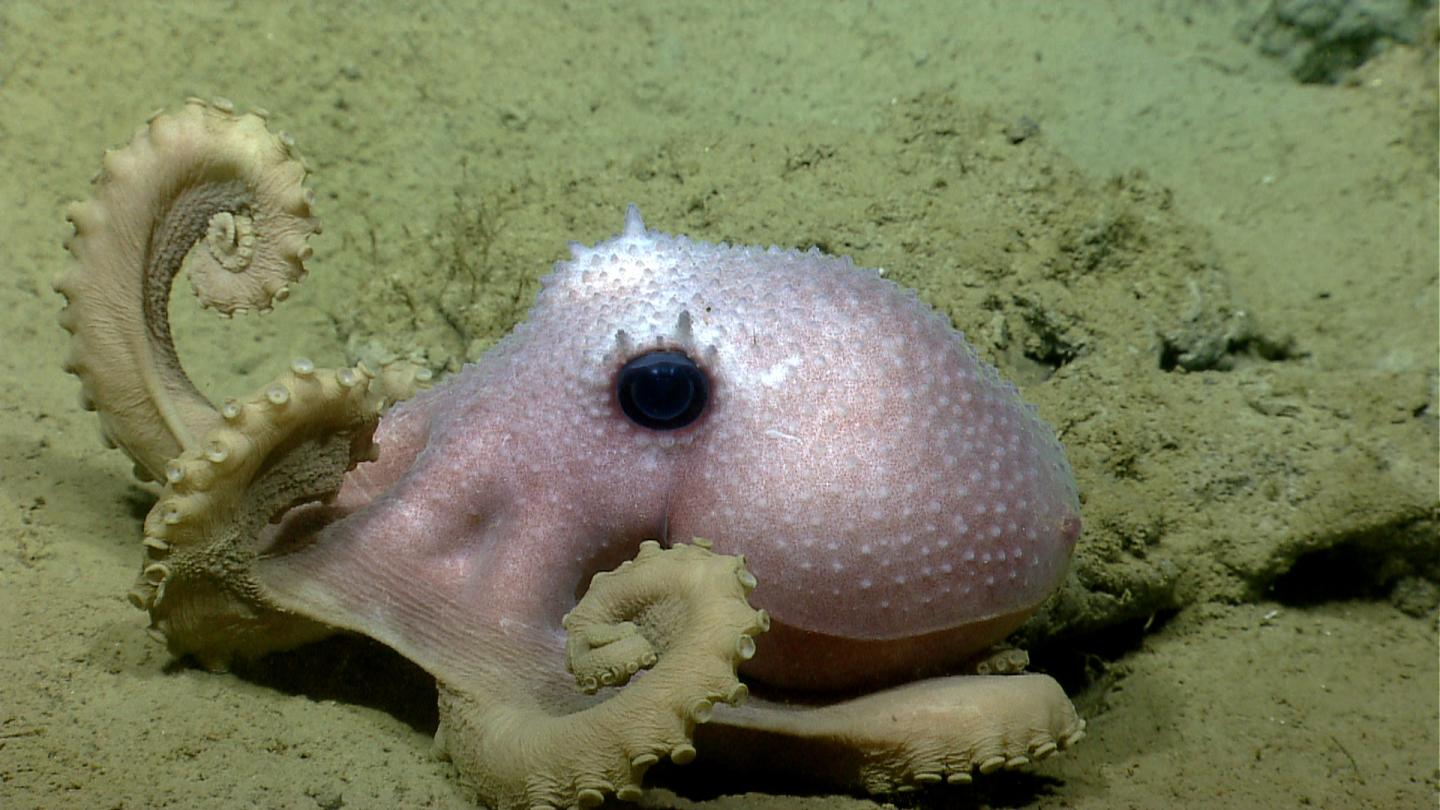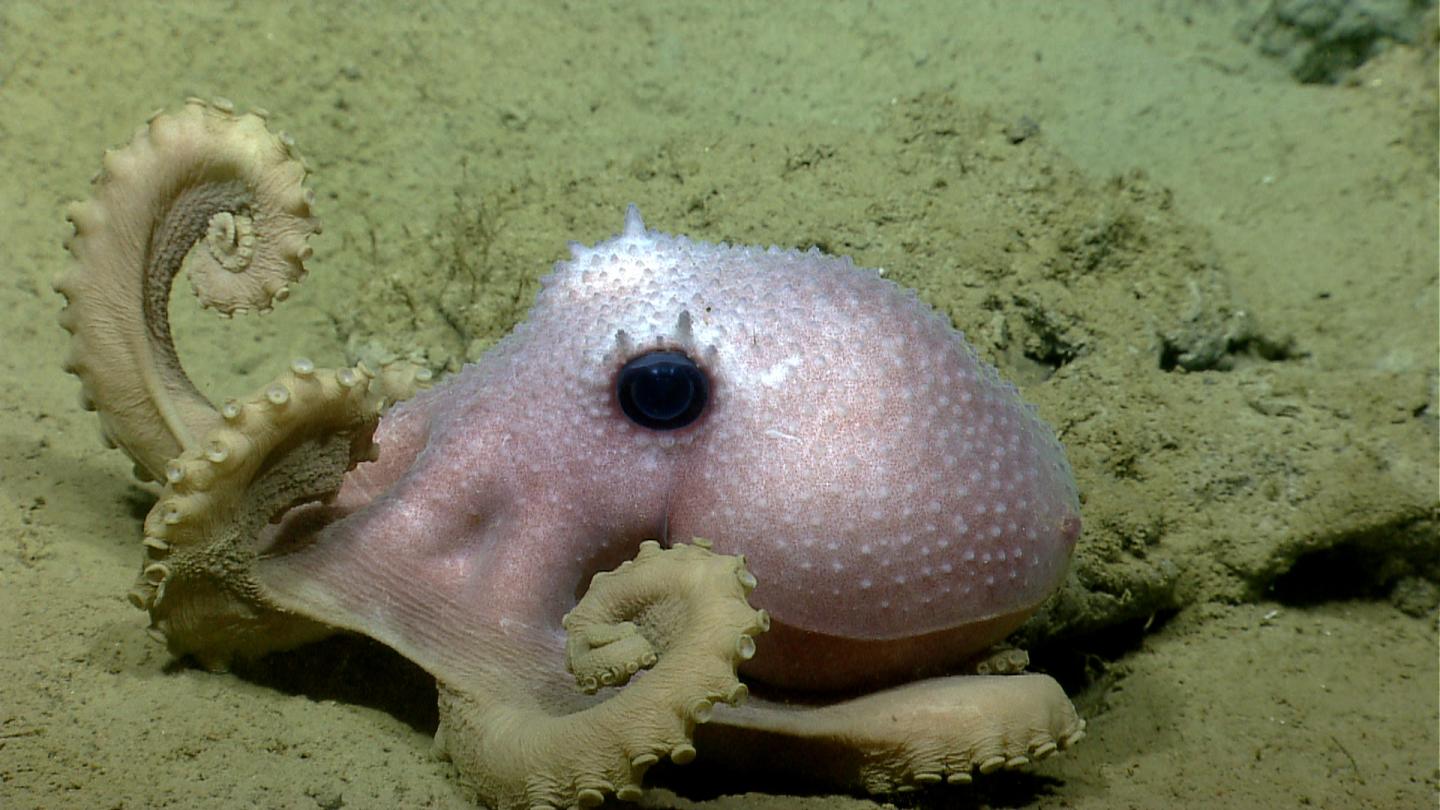
Credit: Photo courtesy of the National Oceanic and Atmospheric Association.
It's usually pretty easy for dedicated scientists with years of experience to tell two species of their favorite organism apart, be it squirrels or birds. The scientists have seen a lot of the animal they specialize in, and the important traits that separate species have been well-documented for centuries. But when it comes to rarely-seen animals in the deep sea, those fundamental assessments are yet to be done.
A new study in Marine Biology Research tackles this issue by comparing the physical characteristics of two similar octopus species that live on the ocean floor, as deep as 9,500 feet (almost 2,900 m) below the water's surface. Both species are pink or purple, and pretty darn cute. The most obvious difference between them is that one lives in the Atlantic and one lives in the Pacific. But there's another difference: their warts. Both species have raised, bumpy warts on their mantles (the rounded part that looks kind of like a head) and on their arms, but the Pacific octopuses, it turns out, are wartier than their Atlantic cousins–their bumps go further down their arms and mantles. That little piece of information could be a big help in ongoing deep-sea research.
"This study illustrates how little we really know about animals in the deep sea," says lead author Janet Voight, Associate Curator of Invertebrates at The Field Museum in Chicago. "Being able to tell different species apart is the basis for understanding those species. You can't really talk about a species if you can't separate it from others like it, or tell if a species is endangered, if you can't tell what the species is."
Co-author Jessica Kurth of Pennsylvania State University, who worked with Voight at the Field, summarized their findings, explaining, "In this study, we used skin texture to differentiate deep-sea octopus species that closely resemble one another. Our research will contribute to the greater understanding of biodiversity, breadth, and evolution in the deep sea."
The two octopus species in this study, Graneledone verrucosa and Graneledone pacifica, were assigned names years ago, but this is the first study to rigorously compare species in the genus, which all are warty and pretty darn cute. Voight and Kurth analyzed seventy-two octopus specimens, most from the Field's collections, assessing where the warts are and where they are not and devising a method to quantify the subtle differences that help separate the species.
Voight notes that while this kind of comparison isn't glamorous, it's crucial to science. "Nobody has sat down with dozens of these octopuses and compared them. There are so many things like that in museum collections, just waiting for the right scientist to come along and use the information they offer," says Voight. "This study shows the importance of museums, of having multiple specimens to compare. If you only have two individuals, you don't know what's important and what's not–it'd be like meeting a person with blonde hair and a person with brown hair and concluding that they must be different species."
While DNA analysis is useful in differentiating between species, it's not always possible. "Our study included specimens collected in the 1950s, and tissue wasn't preserved for DNA work," explains Voight. "Plus, actually going to the deep sea is outrageously expensive, so a lot of the study of these animals happens through video or still images from submersibles. If you have a good understanding of what to look for, the images allow you to identify something that's new." That's already starting to happen–when reviewing video footage from the Atlantic, Voight noticed an octopus whose wart pattern didn't match the species in that region. It could be the first step in discovering a new species, she says.
Beyond the potential for discovery, says Voight, this study gives us a deeper understanding of these creatures. "Octopuses are only distantly related to us, but we have so much in common," she explains. "Our eyes are very similar. They change their behavior based on past experiences–they learn. Deep-sea octopuses are some of the smartest animals we know."
Voight is hopeful that this study will simplify and thus improve the work of scientists studying deep-sea octopuses for years to come. "This study should make future octopus analysis easier and more rigorous. I'd be happy if that happened."
###
Media Contact
Kate Golembiewski
[email protected]
312-665-7103
@FieldMuseum
http://www.fieldmuseum.org
############
Story Source: Materials provided by Scienmag





